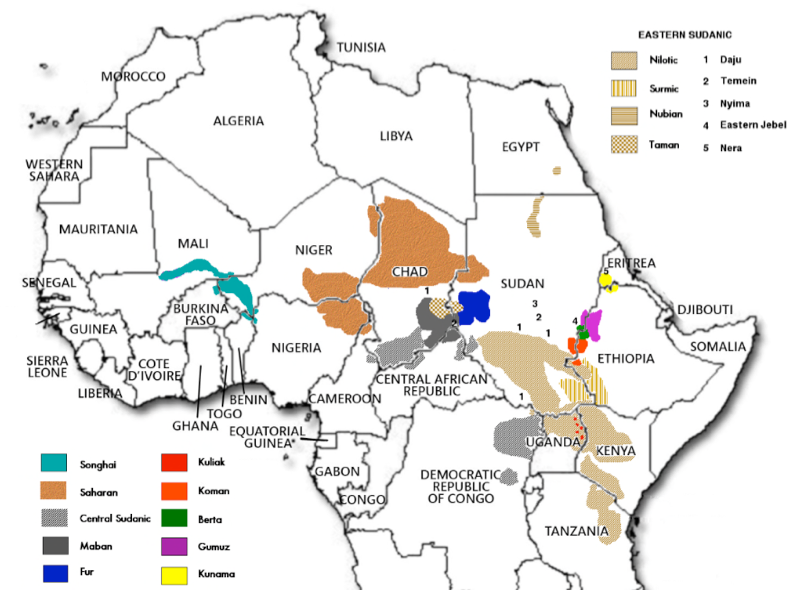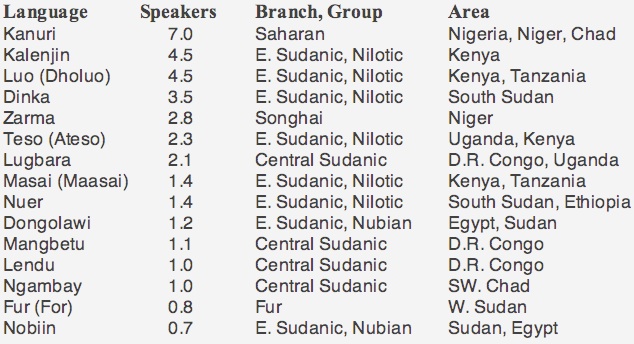An insatiable appetite for ancient and modern tongues


Overview and Distribution. Nilo-Saharan is one of the four major African language phyla, together with Afro-Asiatic, Niger-Congo and Khoisan. Nilo-Saharan languages are spoken by 46 million people in a central belt extending westwards from east of Lake Victoria through southern Sudan and Chad, parts of Niger and Nigeria up to Mali in West Africa.
Classification. The Nilo-Saharan phylum encompasses about 130 languages grouped into a large Eastern Sudanic branch plus 1o additional minor branches, namely Central Sudanic, Maban, Kuliak, Songhay, Fur, Saharan, Gumuz, Koman, Berta and Kunama.
-
Map of Nilo-Saharan languages distribution

-
a)Eastern Sudanic (Chad, Egypt, Sudan, South Sudan, Eritrea, Ethiopia, Kenya, Tanzania, Uganda). It is spoken by about 22 million people and is divided into the following groups:
-
•Nubian languages (South Egypt and Sudan): Dongolawi, Nobiin, Midob, Hill Nubian. To them should be added the extinct Old Nubian, probably the ancestor of Nobiin. Around 2 million speakers.
-
•Nera or Nara (western Eritrea). Spoken by around 90,000 people.
-
•Temein (Nuba Hills in Sudan). Temein, Doni, Tese. Less than 20,000 speakers.
-
•Nyima (in the Nuba Hills of Sudan): Nyimang (Ama), Dinik. Around 100,000 speakers.
-
•Eastern Jebel (East Sudan): Gaam (the largest), Aka, Kelo, Molo. Around 80,000 speakers.
-
•Surmic (SW Ethiopia and South Sudan): Majang, Kwegu, Me'en, Suri, Didinga-Narim, Murle, Tennet, Kacipo-Balesi. Around 400,000-500,000 speakers.
-
•Daju (South Sudan, Chad): Shatt, Logorik (Liguri), Daju Mongo (Dar Daju), Dar Sila, Nyala (Daju Dar Dur), Njalgulgule. Around 250,000 speakers.
-
•Taman (western Sudan and eastern Chad): Tama, Sungor, Mararit. About 200,000 speakers.
-
•Nilotic (North Tanzania, West Kenya, North Uganda, South Sudan, Sudan and Ethiopia). It is the largest Eastern Sudanic group. It has about 18.7 million speakers and is divided in Western, Eastern and Southern subgroups:
-
1.Western: Dinka, Luo, Nuer. Totalling 9.4 million speakers.
-
2.Eastern: Bari, Kakwa, Teso (Ateso), Karamojong, Toposa, Turkana, Lotuko (Otuho), Masai (Maasai), Samburu. Totalling around 4.7 million speakers.
-
3.Southern: Kalenjin, Datooga. Spoken by 4.6 million.
-
b)Central Sudanic (South Sudan, Central African Republic, Chad, Cameroon, Uganda, Democratic Republic of the Congo,). Close to 10 million speakers. It is divided into the following groups:
-
•Lendu (Democratic Republic of the Congo): Lendu, Ngiti. About 1.2 million speakers.
-
•Mangbetu (Democratic Republic of the Congo): Mangbetu, Lombi, Asoa. More than 1.1 million speakers.
-
•Moru-Madi (South Sudan, Democratic Republic of the Congo, Uganda): Lugbara, Aringa, Logo, Madi, Moru. More than 4 million speakers.
-
•Mangbutu-Efe (Democratic Republic of the Congo, Uganda): Mangbutu, Mvuba, Ndo, Mamvu, Lese, Efe. Around 400,000-500,000 speakers.
-
•Sara-Bongo-Bagirmi (Central African Republic, Chad, South Sudan). Includes 40 languages, namely: Jur Modo, Bagirmi, Naba, Gulay, Ngambay (the most numerous) and Sara. Around 3 million speakers.
-
•Kresh (South Sudan): Kresh (Gbaya), Aja. Might be 20,000 to 30,000 speakers.
-
c)Saharan (around Lake Chad, i.e., Chad, Niger, Nigeria, Cameroon): Kanuri, Tedaga (Teda), Dazaga (Daza), Zaghawa (Beri). Around 7.5 million speakers.
-
d)Songhay (Niger, Mali, Burkina Faso, Benin, Nigeria): Zarma (Niger), Koyra Chiini (Mali), Koyraboro Senni (Mali), Dendi (Benin), Central Songhai (Burkina Faso), Tadaksahak (Mali), Tasawaq (Niger). About 4 million speakers.
-
e)Maban (in the border area of Chad, Sudan and Central African Republic): Maba, Masalit, Marfa, Aiki. Around 800,000 speakers.
-
f)Fur (in western Sudan and eastern Chad): Fur, Amdang. About 850,000 speakers.
-
g)Kuliak (northeastern Uganda): Ik (the major language), Soo, Nyangi. About 10,000 speakers.
-
h)Koman (in the border between Sudan and Ethiopia): Uduk, Kwama, Komo, Opuuo, Gule (extinct). Possibly 50,000 speakers.
-
i)Berta (in the border between Sudan and Ethiopia): Berta with 270,000 speakers.
-
j)Gumuz (in the border between Sudan and Ethiopia): Gumuz with around 250,000 speakers.
-
k)Kunama (Eritrea, Ethiopia): Kunama, Ilit. About 200,000 speakers.
Major Languages and Speakers. Around 46 million people speak a Nilo-Saharan language. The most important are (speakers in millions):

SHARED FEATURES
-
✦ Phonology
-
-Tones. Most Nilo-Saharan languages are tonal, having two to four tones. However a few, on the periphery of Nilo-Saharan and in contact with non-tonal Afro-Asiatic languages, appear to lack tones (e.g., some varieties of Songhay and Nubian). Tones are used more often to mark grammatical distinctions than to make lexical ones.
-
-ATR vowel harmony. Some branches of Nilo-Saharan, like Central Sudanic, and the Nilotic and Surmic groups of Eastern Sudanic, exhibit advanced tongue root vowel harmony, in which two sets of contrasting vowels (ATR+ and ATR-) never coexist in the same word. ATR+ vowels are pronounced by moving the base of the tongue forward, being perceived as "tense" or "bright", while in ATR- vowels the tongue remains in neutral position.
-
-Consonants. Implosives occur in Central Sudanic and in East Sudanic groups (such as Surmic, Tama and Daju) as well as in Gumuz and Koman. Labial-velar stops (like kp and gb) are found only in Central Sudanic and a few neighboring Nilotic languages as well as in Songhay. Some Central Sudanic languages, like Kresh and Mangbetu, have labiodental flaps.
-
✦ Morphology
-
Nominal
-
-Nominal case marking systems are widespread across Nilo-Saharan but are absent in areas contiguous to Niger-Congo languages. Cases are marked by suffixes or tonal differences.
-
-Gender is not generally marked except in some Nilotic languages.
-
-Nilo-Saharan languages may have complex number-marking systems. Characteristically, many have singulative marking, i.e., the singular is marked while the plural is the basic unmarked form. Collective nouns may be marked in the singular to single out one item (blood → drop of blood, hair → one hair). Some languages have a three-way number-marking system: in certain nouns the plural is marked, in others the singular, and in others both the singular and the plural are marked.
-
Verbal
-
-Tense/aspect and person/number are marked by affixes sometimes accompanied with consonant mutation. Aspectual distinction between perfective and imperfective is important.
-
-Converbs are frequent in the Nilo-Saharan languages of Ethiopia as well as in some of more western areas. They are non-finite verbs (verbs with reduced inflection) used in dependent clauses to describe successive actions in a narrative.
-
✦ Syntax
-
-Word order varies in different language groups. In some, the verb occupies the initial position (Verb-Subject-Object or VSO), others are verb final (Subject-Object-Verb or SOV). In some others, word order is quite free. In eastern Nilo-Saharan languages the VSO type is more common while SOV is more frequent in western languages.
-
-Syntactical relations are indicated by case-marking and the use of adpositions.
-
© 2013 Alejandro Gutman and Beatriz Avanzati
Further Reading
-
-'The Languages of Africa'. J. H. Greenberg. International Journal of American Linguistics 29 (1), part 2 (1963).
-
-A Linguistic Geography of Africa. B. Heine & D. Nurse. Cambridge University Press (2008).
-
-The Nilo-Saharan Languages. M. L. Bender. LINCOM Handbooks in Linguistics 6. LINCOM (1996).
-
-'Nilo-Saharan'. M. L. Bender. In African Languages: An Introduction, 43-73. B. Heine & D. Nurse (eds). Cambridge University Press (2000).
-
-'Nilo-Saharan Languages'. G. J. Dimmendaal. In The Concise Encyclopedia of Languages of the World, 772-776. K. Brown & S. Ogilvie (eds). Elsevier (2009).
Nilo-Saharan Languages

Address comments and questions to: gutman37@yahoo.com
MAIN LANGUAGE FAMILIES
LANGUAGE AREAS
Languages of Ethiopia & Eritrea
LANGUAGES by COUNTRY
LANGUAGE MAPS
-
• America
-
• Asia
-
Countries & Regions
-
-
Families
-
• Europe
-
• Oceania